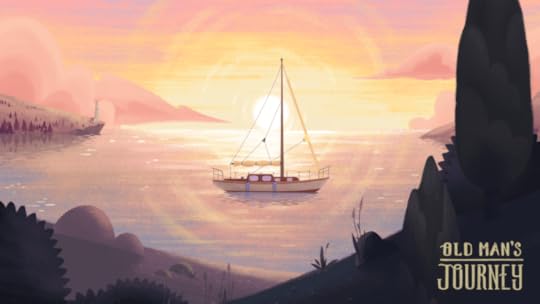Kill Screen Magazine's Blog, page 88
July 20, 2016
Los Santos Pride mod gives GTA a much-needed queering
Notice: Discussion of homo/trans/biphobia
///
“Almost fooled me, bro-she!” says Grand Theft Auto V (2013) protagonist Franklin while passing by a group of trans women. “He’s so deep in the closet, his friends call him mothballs!” yells the game’s parody of Simon Cowell at a contestant on his singing competition. “Post Op: No Longer Just Mail” says the side of one of the game’s UPS stand-in brown delivery trucks as it drives by. Grand Theft Auto V has about one of the most open worlds in gaming, but in jokes like these, much of that world is made inaccessible for all but the most heteronormative of players.
Enter “Los Santos Pride,” a mod from Sweden’s Stockholm Pride festival that hopes to queer the digital city and make its already impressive space even more open by making it welcome to all. “GTA 5 takes place in Los Santos, a city that offers everything from burger joints and night clubs to supermarkets and fashion outlets,” the group writes on its website. “In short, Los Santos has everything you can expect from a real city. Well, except for one thing: a Pride parade.”
Created in collaboration with modders such as scripter JulioNiB, whose previous work includes bringing Hulk and Iron Man to the game, the mod adds a new rainbow-clad parade to the virtual city’s streets, complete with matching flags, DJs, dancers, people carrying signs like “love comes in all colors,” and plenty of attendees watching from the sidelines.
Of course, given Grand Theft Auto’s tendency to break into violence at any point and the difficulty that poses for celebration in light of recent events like the Pulse nightclub shooting in Orlando, Stockholm Pride president Christian Valtersson writes “We’ve made the parade indestructible. Not to moralize, but rather to show that love will always triumph over hate.” Looking at the YouTube comments on the mod’s trailer, that’s probably not a bad idea.
“love will always triumph over hate”
Towards the end of the trailer, pansexual protagonist Trevor, whose sexuality is arguably treated within the game proper as just yet another facet of his unstable personality, leads the parade with his typical gusto, standing on top of a float and waving his arms back and forth without shame. If his queerness was treated as a quirk or wacky detail before, here it is an important and valid part of who he is.
“The game has generated several controversies related to its violence and depiction of women,” Stockholm Pride writes in a press release. “Today, the game is about to get more colorful and inclusive.”
The parade isn’t perfect, as it only features rainbow flags rather than representing a wider cross-section of the LGBT community, but the mod does mark a significant widening of the types of players Los Santos is built to suit. Grand Theft Auto is known for the detail and care put into its spaces, but with mods like “Los Santos Pride,” the game’s more frequently ignored LGBT players are finally getting some of that care as well, even if it had to come unofficially. Your move, Grand Theft Auto VI.
You can download “Los Santos Pride” for free by visiting its website.
The post Los Santos Pride mod gives GTA a much-needed queering appeared first on Kill Screen.
Old Man’s Journey, a beautifully slow game about nearing the end of life
In a market oversaturated with dark shooters and bright pixels, calm games can seem few and far between. Enter Old Man’s Journey, a beautiful upcoming game by Viennese studio Broken Rules that is exactly what the title describes. The teaser trailer, released last Thursday, features a cute, white-bearded old man—our assumed protagonist—and the gorgeous seaside city he’s wandering through.
The tagline describes it as a game about life, loss and hope, “a final chance to seek amends and find your heart, once lost at sea.” The chalky art style and sweet little drawings befit a steadier pace, so there’s no rushed adventuring to be found here. The puzzles are light-hearted, Broken Rules say, and promote “playful, inquisitive” interaction. In contrast to all of these games about growing up, Old Man’s Journey is about growing old.
Broken Rules CEO Felix Bohatsch described the initial keyword for the concept of the game as “Fernweh,” a German word similar to our concept of wanderlust, but implying an almost painful separation. Fern-, the prefix, means distant or far-off, and -weh is the word for hurt or pain. Felix then explained that the team was interested in exploring how traveling alone often leads to introspection: so that their character could “[reflect] on their life’s choices,” they chose an older character with an entire life to remember.
“there are enough fantasy and space games out there”
The studio also drew on what has become a new and wonderful experience for most of the members: parenthood. Broken Rules’ founders have seven children from 3 months to 6 years between them, and the balance between family, work and personal needs was another inspiration for a more introspective narrative.
The game is set in the Alps, a setting it shares with Broken Rules’ earlier games Secrets of Raetikon (2014) and Chasing Aurora (2012). Broken Rules likes to explore environments that they’re familiar with—they’re Austrian—and so Old Man’s Journey is set right on the other side in little fictional towns in France, sometime in the ’90s. “Let’s be honest, there are enough fantasy and space games out there,” Bohatsch quips; he prefers to work with what he knows.
But Broken Rules don’t want to take everything from their earlier games. From their experiences with Secrets of Raetikon, a puzzle-based exploration game, and Chasing Aurora, a multiplayer action game, they realized that it hindered accessibility and focus to work in too many gameplay elements at once. Secrets of Raetikon often felt confused, Bohatsch said, and Chasing Aurora’s reliance on a specialty controller made it unrealistic to play as intended, so Old Man’s Journey is going to pare down those ideas to a single, simple mechanic, with the slower pace intended to make the game more accessible and easier to play. A calm game about the waning end of a life has no interest in exclusion.
Fortunately, their hard work and thoughtfulness is already paying off. Old Man’s Journey was recognized in this year’s Pax 10, and when you look at the confidence it already shows, it’s not surprising. Broken Rules haven’t announced platforms or price yet, and the only release date given is 2017, but they’re not rushing. And neither is the old man.
Old Man’s Journey will be out next year.
The post Old Man’s Journey, a beautifully slow game about nearing the end of life appeared first on Kill Screen.
Videoball brings fair play back to the couch
I didn’t know what a metagame was until I got to college, but I didn’t really need to. Playing multiplayer games on the couch with my cousins, we’d concoct all sorts of techniques and strategies that weren’t explicitly outlined in the manuals. In Worms 2 (1997), we all fought against each other using only a couple of choice weapons, despite the game’s massive arsenal: the Holy Hand Grenade was devastating and hilarious, the Super Sheep offered range and control, and the Ninja Rope gave us all the mobility we wanted. This is probably not the competitive Worms 2 metagame (I’ve never actually seen it played at a high level) but it was ours, and before high-speed internet and esports, all the game knowledge we could possibly need could be found there, taking turns at the computer desk.
Smash cut to 2016 and metagame is everything. You can’t just be good at Super Smash Bros. or League of Legends (2009), you have to be part of the community. You can’t just teach yourself the basics, you have to watch YouTube tutorials and learn L-cancels, wavedashes, bunny hops, orbwalks, etc. There’s no doubt that meta-techniques add depth and longevity to multiplayer videogames, but it feels like we’re giving up something in exchange—it’s like we’re always playing on a national stage, and there’s simply no such thing as a couch metagame anymore.
Fighting off Big Meta
Videoball is a new game from Action Button and Iron Galaxy Studio that tries its hardest to bring us back to those days when mechanics weren’t set in stone and optimal strategies didn’t dictate every single move. As a sort of 2D mashup between Asteroids (1979) and Rocket League (2015), Videoball pits teams of triangle-shaped players against one another on a rectangular field, and asks them to shoot projectiles at the ball until it goes into the opponent’s goal. It’s easy to pick up, and Action Button’s clean design aesthetic makes all of the action easy to parse from a visual standpoint.
As tends to be the case with these easy-to-learn multiplayer games, Videoball features a slew of details that gives it a tough-to-master, rock-paper-scissors-style moveset. A light shot won’t move the ball much, but it’s great for distracting an enemy or firing down their projectiles. A medium shot (my preferred projectile) will carry the ball for as long as its triangular physics will allow, but since the ball will eventually glance off one side of the projectile, only a direct hit will reward the player with any significant distance. Finally, there’s the full charge shot, which can fire the ball clear across the map but can be very easily deflected—even by a light attack. Players can also leave square-shaped barriers on the map for defense, which only disappear when another player destroys it with projectiles.
https://killscreen.com/wp-content/uploads/2016/07/videoball-shot_600.0.mp4
This setup is ripe for technical experimentation, and it heavily rewards strategic thinking that goes beyond the prescribed mechanics. Most of the time, it seems like Videoball’s prime concern is to inspire its own brand of DIY metagaming. Playing against CPU-controlled opponents named “Lefty” and “Righty” helps teach the basics of zone control. Similarly, playing against a CPU team comprising “Tippy” and “Toppy” helps teach the player about how to counter rudimentary teamwork, like when one teammate constantly tips the ball to the player on the top side of the map.
Beyond the cutely-named AI opponents, Videoball emanates this sense of delight that helps encourage the sharing of mechanics and experiences and strategies. The game actually gives players a good start toward this end by imbuing each of its basic moves with specific names. Shooting the opponent is referred to as a “tackle,” for instance, while hitting a projectile is called an “intercept.” Medium-charged shots are referred to as “drives”, while fully-charged projectiles take on the loving title of “dunks.” Each technique has a different use, and just as it is in many other competitive games, the best players will be able to use each of these movements optimally for a given situation.
Videoball’s prime concern is to inspire its own brand of DIY metagaming
In my time playing Videoball, I came up with a few moves myself. There’s the “Drift Shot,” which uses my avatar’s slip-slidey momentum to drift toward one side of the ball while angling my projectiles toward the enemy goal. Then there’s “The Turnaround,” where I run away from an oncoming ball while charging up a shot, then quickly turn around and send it flying toward my enemy. I’ve also got the “Slide Drive,” where I put the ball up against the wall of the arena and angle my medium-charged projectile in such a way that it perfectly carries the ball all the way to the enemy’s goal. There are hundreds of little techniques like these that I might have picked up on, and I probably would have given stupid names to all of them.
Videoball wants to give players the tools they need to develop and share their unique playstyles, but as an online-enabled game, this is a herculean task. Give the game two months, and players will undoubtedly come up with a definitive nomenclature for the advanced movesets. A search for “Videoball Tutorial” will yield thousands of YouTube results. And we will all get our asses handed to us whenever we play online.
But in a noble effort, Videoball does things to try and counter this. First off, the game comes with 35 maps, which allows for more customizable matches and allows players to avoid the tyranny of standardization. When you bring the available gameplay modifiers into the equation, Videoball does a lot to reinforce the idea that there’s no “right” way to play. Another way Videoball fights off Big Meta is by supporting local cooperative play, which gives couch-sharers more stuff to do when they get tired of playing against each other. Finally, everything about Videoball just feels like it’s trying to knock down barriers to entry by way of art and design. Its interface is bubbly and peaceful and covered in gradients. Its mechanics are simple. Its music reminds me of Japanese arcade games from the ‘90s. And while it can sometimes look like Videoball is trying a bit too hard (its voiceover work can be a little on-the-nose), it’s all in service of making the game more accessible.
Something interesting happens when you excise the concept of a national meta from a multiplayer videogame: you tap into a sense of shared competition that hasn’t really existed since the birth of broadband internet connections. Under the etiquette of shared play, everyone must act like the game does not exist outside of the couch. The whole experience transforms into this pared-down, basic competition to see whose talent grows faster when given the exact same timeframe to improve. You’re no longer pulling from an experience pool of days, but of hours. And honestly, if we’re sitting down on the couch next to each other, I have pretty much no interest in pitting your 30 hours of experience against my zero. Practice is for tryhards, and Videoball’s greatest strength is that it understands the value of isolated, localized competition.
For more about Kill Screen’s ratings system and review policy, click here.
The post Videoball brings fair play back to the couch appeared first on Kill Screen.
July 19, 2016
Stop everything! Kentucky Route Zero Act IV is out right now
Just like last time, Kentucky Route Zero‘s next act—that is, Act IV—has dropped with a soft thump into the world. If you already own it then this new act will be available to download in your Steam library right now. Did you hear it land? Nor did anyone else.
Alongside this sudden arrival, Cardboard Computer posted an “Observational Trailer,” which is the most pleasant three minutes I’ve ever spent staring at a gas station lit like a biker bar. You can also spend the next three minutes doing that, perhaps sipping on something cold—yes, do that:
So far, acts One through Three of Kentucky Route Zero have made up a game about moving through space, and financial hardship, and turning into a glowing whiskey skeleton at inopportune moments. Full of musical interludes and barebones staging, a real sense of theatricality pervades the environments and the conversations of Kentucky Route Zero. Dialogue offers choices: no ways out, only ways to think about the state of things.
here we are at the mouth of the Echo
Between the mysterious phonebooth toy and the real-life oddball telephone that dials only the number for the Echo River guide provided by the Bureau of Secret Tourism, we’ve been on our toes for some time now, wondering who’s on the other line, but all of a sudden, here it is, and here we are at the mouth of the Echo. Oh, and not only that, but we here at Kill Screen have more on Kentucky Route Zero coming for you soon in the forthcoming Issue 9 of our print magazine (subscribe to be the first to get it here). It’s gonna be good. Just wait a little longer to see…
Kentucky Route Zero Act IV is available on the Humble Bundle, through Steam, and now through itch.io too.
The post Stop everything! Kentucky Route Zero Act IV is out right now appeared first on Kill Screen.
Ikenfell will let you relive your childhood dreams of going to magic school
Like any human being who was between the ages of three and 30 when the Harry Potter books were coming out (we’re talking 1997 here), I always wanted to be a wizard. Besides the obvious advantages of being magic, so much of that world was impossible to resist, from Bertie Botts Every Flavor Beans right down to the Quidditch pitch and those terrible screaming bowling balls that broke Harry’s arm that one time. I was entranced, up until my 11th birthday, where an empty mailbox single-handedly destroyed all my faith and childhood wonder (it happens to all of us.) Still, I never really left the desire to run away and learn magic behind.
If you went through a similar experience, upcoming wizard-school-in-development game Ikenfell should be right up your alley. Created by designer Chevy Ray, artist Hunter Russell and sound designers aivi & surasshu (who also work on Steven Universe!), it’s an upcoming Japanese-style RPG with a unique twist on the fantasy setting.
instead of playing the Chosen One, you’re kind of a nobody
Like Harry’s numerous adventures, it takes place within a school for budding magicians. Instead of Hogwarts, the school in question is Ikenfell, and instead of playing the Chosen One, destined to kill Voldemort or bring balance to the Force or whatever, you’re kind of a nobody. Maritte, the player character, doesn’t have magic. She doesn’t go to Ikenfell. But her sister did, and now her sister’s gone, and you have to find her. Cue game.
During your heroic quest to find your sister, you’ll encounter tons of different characters, explore the massive school that we can only hope has stable staircases, and learn magic, which you can use to duel other characters through a turn-based battle system. The Kickstarter trailer shows big, multi-character duels that look to be somewhat tactical, but as Ikenfell is influenced by Paper Mario (2000), Earthbound (1994), and Carry On (2016) as well as Harry Potter, it aims to be quirky as opposed to classic. Based on the screenshots we’ve seen so far—bright and colorful, like if Filch had had a better life—it’s definitely on its way.
Ikenfell’s already made its Kickstarter goal, but its creators are still aiming for the stretch goal of a full-length soundtrack once they hit 50k. They’re going to release on PC and Mac as well as Linux if all goes well, and you can still pledge until July 23rd. Come on. Didn’t we all want to go to Hogwarts?
Check out and perhaps support Ikenfell over on Kickstarter.
The post Ikenfell will let you relive your childhood dreams of going to magic school appeared first on Kill Screen.
The most kawaii first-person shooter gets a sequel this Friday
The classic idiom goes “Don’t judge a book by its cover,” but often the aesthetic and visuals of a medium offers a reasonably good idea of what to expect. One doesn’t imagine that dark horrors are lurking behind the sunny facade of Sesame Street (the webseries Don’t Hug Me I’m Scared subverts that expectation to an unsettling effect), or that the Berenstain Bear children books will descend into mature adult themes. A game’s looks inform us in the same way, as seen in the bleak muted palette and Orwellian environments of this year’s Inside, the vibrant island of The Witness, and the watercolor landscape of Beyond Eyes (2015).
But sometimes that facade can be deceiving. The puzzler Snakebird (2015) presents itself with bright color levels and charming serpentine avians, but hides a fiendish challenge. Toki Tori‘s (2001) chirping and cute animal friends coalesce into a surprisingly complex puzzle game with interconnected rules to learn and master. Acclaimed mobile game A Dark Room (2013) blossoms into a much larger experience than its single text prompt and basic interface would imply. Gaming is rife with examples like these, where aesthetic and gameplay juxtapose each other in fascinating ways.
Lovely Planet (2014) was one such title. On the surface, it was a bright game popping with color and odd-cubic enemies, hearts and technicolor décor. But actually play the game, and you found a fast-paced test of reflexes and precise shooting, driven by the vein of die-restart-die-improve pacing that defined titles such as Hotline Miami (2012) and Super Meat Boy (2010). A gauntlet of enemies and projectiles and long gaps to cross, propelled by the ever-ticking clock.
A fast-paced test of reflexes and precise shooting
Its forthcoming follow-up Lovely Planet Arcade doubles-down on that contrast. An expanded sequel with more levels and game modes, the aesthetic is even brighter: the dull sky of the original now a vivid blue, cubic enemies now rounded and softer. The action has been likewise upgraded; armed with a heftier musket-like weapon in your hands—compared to the first’s magical staff—you rush through the game firing on shielded foes and incoming rockets with honed precision.
Of course, a sequel wouldn’t be complete with new ideas for you to learn, and Lovely Planet Arcade‘s new additions challenge you to react on the fly. You have to make sure not to shoot friendlies, but to shoot bombs before they hit the ground—training hesitation into your urgent reactions. A particular enemy type freezes time when you kill it, offering a few precious moments to take aim without the pressure of the clock. Portals transport you to different areas. Along with special modifiers and new modes, Lovely Planet Arcade promises to take the charming-yet-challenging action of the original
Lovely Planet Arcade will be out on July 22nd for PC, Mac, and Linux. More details can be found on the game’s website.
The post The most kawaii first-person shooter gets a sequel this Friday appeared first on Kill Screen.
Ian’s Eyes will have you play as a guide dog for a blind kid
When you’re the “new kid” the first day of school can be extremely scary. I’ve been the new kid at a new school in a new town. You have to quickly figure out a large number things in a short amount of time. You’re trying to figure out the layout of not just the school but the town too. You are trying to memorize names and attach them to faces. Trying to desperately find someone to talk to, someone who maybe will be a friend. That first day of school in a new town as the new kid was terrifying. So, I can’t even imagine how much more challenging and scary a first day at school must be for a child who is blind.
Ian’s Eyes is about that very experience. Ian is a young boy arriving at a new school. Ian is blind, but luckily, he isn’t alone. He has a trusty and ever-loyal guide dog. And it’s this guide dog, not Ian, that the player will be controlling. Playing as a dog and helping a young kid was the initial idea that led the small team of Sindie Games to create Ian’s Eyes.
“We always wanted you to play as the dog,” Ana Coronado, the lead artist on Ian’s Eyes told me. But the team needed a reason why the boy needed the dog’s help. “We were thinking ‘what would make sense?’ and the natural idea was that the kid had to be blind and you the dog had to guide him.”
The reasoning behind setting Ian’s Eyes in a school came from Sindie Games being a smaller team and this being their first game. Exteriors are harder to create so the three person team decided to set the game somewhere that would be small and consist mostly of interiors. Setting the game in a school also led to the decision to set Ian’s Eyes during Ian’s first day of school. Unfortunately for Ian, his first day of school is filled with deadly zombies. And it’s up to you the player to help guide Ian through this nightmarish schoolhouse.
“You can bark, run, or use stealth”
One of the biggest challenges Sindie Games faced early on in development concerned the dog and what it would do. “At the beginning we had a bit of a struggle thinking of mechanics that were fun and realistic at the same time,” Coronado said. She also listed some of the mechanics that the dog is capable of in Ian’s Eyes: “You can bark, run, or use stealth. What the player has to do is to clear the way so Ian can pass safely.”
Depending on the situation, the player will use these options to keep zombies away from Ian. An example that Coronado described was having to bark and make a lot of noise to bring zombies to you and away from Ian. But while the player has different options for keeping Ian safe, Coronado clarified that violence isn’t an option. “There is no attacking in it, so the dog never fights against the zombies.”
Recently, Ian’s Eyes was successfully Greenlit on Steam and it now has a Steam Store page. The game won’t be out until later this year, but Ian’s Eyes is already getting lots of feedback from fans. Coronado says the team is happy and all of the support is “giving us the energy to keep working on Ian’s Eyes.”
Ian’s Eyes will be available later this year on Steam for PC. The team is hoping for more platforms in the future. You can also check out the Ian’s Eyes twitter account for updates on the game.
The post Ian’s Eyes will have you play as a guide dog for a blind kid appeared first on Kill Screen.
A Light in Chorus gets a proper story to go along with its magical visuals
We’ve had our eyes on Broken Fence Games’s A Light in Chorus for a while now. It’s hard not to look at this game, because it’s absolutely stunning. Its world is composed of glowing dots, like a starfield held in tremulous pointillism. So far that visual allure has made for gorgeous screenshots and GIFs, but the meat of A Light in Chorus—that is, how do you interact with this world?—has remained pleasantly elusive.
I’m not asking “how you play it;” I’m not hoping to, like, max out my light-viewing skill tree or anything (please, no!). Our own Jess Joho did impressive work last year teasing out the implications of the game’s then-ephemeral systems, but I’m here with an easier job: to tell you, reader, that yes, A Light in Chorus does now have a story.

Your mission in A Light in Chorus is to reconstruct Earth as it was before it was engulfed by oceans. To that end you have a magic (maybe? maybe!) record player capable of, per the designers, “transforming the world around you into a musical light show, at the press of a button.”
an allusion to the golden records sent into space
In other words, it turns future-Earth from a submerged voidscape into that beautiful accretion of celestial light. This debatably magical record player is an allusion to the golden records sent into space aboard the Voyager probes in 1977, which contained all sorts of information on humanity. Sort of like a time capsule, if you were also sort of hoping your time capsule could contact alien civilizations to get your entire species out of this mess.
Broken Fence sound pretty galvanized by this new focus, saying “it has transformed so much of the way we’re now designing things.” With a grant from the UK Games Fund freshly in hand and a promise of “more good news” at the start of August, we can assume A Light in Chorus will soon be making its final descent into the atmosphere we like to call “retail release.”
Below are more GIFs that you are now obliged to stare at in awe. Find out more about A Light in Chorus on its website.




The post A Light in Chorus gets a proper story to go along with its magical visuals appeared first on Kill Screen.
Card Thief brings medieval stealth to the card game format
Card Thief is an upcoming game from the Tinytouchtales studio headed by Arnold Rauers. Inspired by Thief (1998) and Sage Solitaire (2015), it will see players extinguishing torches and sneaking past salivating dogs to string long chains of cards together as the obstacles mount up. Tinytouchtales’s last effort, Card Crawl (2015), also used a more-or-less standard deck of cards to blend dungeon crawling and Solitaire.
At some level, Solitaire isn’t a card game anymore. Or, it’s not a game you play with cards. Microsoft Solitaire (1989) was developed by Wes Cherry with art by Susan Kare in an effort to help new computer users get comfortable with the interface. While not the first computerized version of Solitaire, it involved using a mouse to drag and drop boxes around the screen, which was a relatively novel way to interact with a machine. As a familiar game, Solitaire was a low-stakes way to let people enjoy teaching themselves how to use their new computers. In 2005, Microsoft revealed that the three most popular games on Windows were Spider Solitaire, Klondike Solitaire, and FreeCell.
Despite the playing card’s 200-year head start, I suspect that by now more games of solitaire have been played on computers than with cards. While the standard 52-card deck produced the original randomly-generated games, now we tend to play these games on our phones. This year’s Donald Rumsfeld-designed Churchill Solitaire is a game Churchill reportedly used to play with cards, but it starts to get complicated when you need two decks of cards, a whole table to play on, and have to score your own games. It definitely isn’t a game you could play on the train, or while waiting for a friend.
Some cards have lit torches on one sides, and dark on the other
On top of that, games like Donsol (2015) and Sage Solitaire are designed to be played on touch-screen devices, but use the same widely-known format of the four-suit 52-card deck. Just like Microsoft used Solitaire to ease users into Windows, a developer working on a complicated game can assume a player is familiar with the deck of cards, and can use that as a starting point for introducing concepts that would otherwise have to be taught.
This is how Card Thief can bring in ideas from stealth games. Some cards have lit torches on one sides, and dark on the other; guards have a changing directional gaze, the player’s thief has a stealth meter that depletes as they dart through illuminated areas or bump past guards. But because the tiles are large, tappable objects with clear numbers and interactions, it doesn’t look finicky or hard to control, it looks complex and tense.
Find out more about Card Thief on its development blog.

The post Card Thief brings medieval stealth to the card game format appeared first on Kill Screen.
A new biomechanical fantasy for the curiosities of children and adults alike
What is the art that sticks with us as children? Is it the pleasant ones? The ones that are comforting and safe? Or are they the strange ones? The ones that first expose us to to a world beyond the pre-approved bubble of sanctioned entertainment? In a time when getting media to everyone—including children—is easier than ever, Danish artist Malte Burup took the opportunity to craft an interactive children’s book that could be both challenging and entertaining. Titled Sofus and the Moonmachine, his storybook is a chance to deliver a quality app for children without compromising his vision for a living, breathing, biomechanical world that could spark that strange curiosity within them.
children’s books are more daring than stories for adults
Sofus and the Moonmachine is a story that takes place on a forested planet inspired by artists like Sweden’s John Bauer, and Australia’s Shaun Tan. Sofus lives on this planet, building things out of fallen scrap metal from the Moonmachine, an orbiting mechanical planet that lights up to become the Sunmachine, which sustains the plant life on Sofus’s planet. One day however, the Moonmachine breaks down and Sofus takes it upon himself to build a rocket so that he can travel to the machine planet and fix it.
This combination of natural organics and functional machinery was partly inspired by the works of H.R. Giger in the Alien series, and it shows most prominently on scenes that take place on the Moonmachine. Nature and machine are visual themes that run through Sofus and the Moonmachine, evoking the works of Hiro Isono (Secrets of Mana) and Adolf Lachman (Machinarium). The latter being a kindred artist to Burup’s own personal style.
For Burup, children’s books are more daring than stories for adults. As he says, children’s books “can allow for more randomness and bizarre things to happen, without the children questioning it.” He also says “grown-ups tend to put everything into categories and become confused if something is off.” So, taking his inspirations, Burup’s Sofus and the Moonmachine presents a wonderfully weird world with engaging puzzles and charming rhymes to capture wild imaginations and deliver an enthralling book both children and adults can interact with.
You can download Sofus and the Moonmachine on the App Store for iOS. Also check out its website for more info.
The post A new biomechanical fantasy for the curiosities of children and adults alike appeared first on Kill Screen.
Kill Screen Magazine's Blog
- Kill Screen Magazine's profile
- 4 followers














